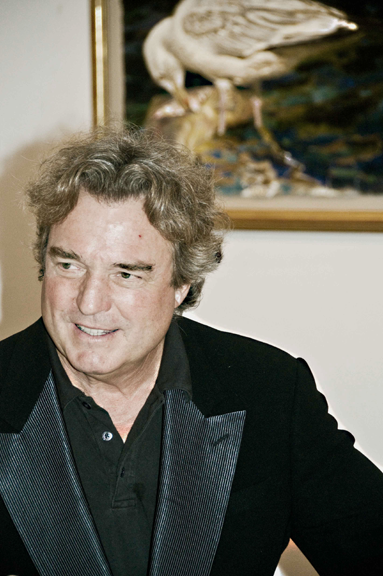By Sabina Clarke
An absolutely spectacular exhibition, Seven Deadly Sins, by renowned artist Jamie Wyeth, son of recently deceased Chadds Ford artist Andrew Wyeth and grandson of the famous artist and illustrator N.C. Wyeth, is on display at Brandywine River Museum in Chadds Ford, PA now through November 22nd.
Greed, sloth, lust, gluttony, anger, pride and envy were defined long ago by early Christian theologians as the Seven Deadly Sins; sins so terrible that they jeopardized the sinner’s spiritual salvation.
Throughout history, there have been only about a handful of artists who have tackled this difficult theme; perhaps the most famous painted treatments of the subject are those of 15th- and 16th-century Netherlandish painters, Hieronymous Bosch and Pieter Brueghel the Elder–and now it has been interpreted once again with brilliance, humor, imagination, abandon and a touch of irreverence by Jamie Wyeth who explores this tradition in a series of paintings depicting raucous scavenging seabirds that personify each of the seven deadly sins. Wyeth says that Paul Cadmus’ paintings of the subject in the 1960s intrigued him and sparked his initial interest in the tradition of the sins.
Wyeth’s choice of seagulls to represent the sins was a natural evolution of his lifelong interest in seagulls which he had observed closely and painted for decades along the coast of Maine and in his studios in Monhegan and Southern islands. In a recent interview at the exhibition, he said, that he was tired of seagulls being portrayed as white doves: “They’re always depicted as white doves, when, in fact, they’re evil scavengers.”
In “Envy” (2005), the bond of friendship between two gulls upsets a third gull who shows an indifferent yet disgruntled expression. In “Pride” (2008), a boastful bird boisterously parades a prized catch-a lobster-in his beak while trouncing upon a competitor. In “Gluttony” (2005), a gull in a feeding frenzy tries to swallow a fat fish and simultaneously devour more that are thrashing to escape. In “Sloth,” a sleeping seagull pays no attention to the raucous feeding frenzy nearby. As a counterpoint to their sins, the seagulls are strikingly graceful and luminous with their grey and white plumage.
Accompanying the paintings are several quotes by writers including the Trappist monk and Catholic theologian Thomas Merton–a writer Wyeth admired. In “Sloth,” Merton says, ‘Untie my hands and deliver my heart from sloth.’ And in “Envy,” Merton says, ‘Stamp out the serpent envy that stings love with poison and kills all joy.’ And in “Lust,” Merton says, ‘Keep me from the murder of lust that blinds and poisons my heart.’
Wyeth’s paintings are exuberant and colorful and surrounded with swirls of bright red and yellow around the perimeter which connect them to his painting Inferno depicting a local youth stoking a hellish fire in a huge moveable tank–a tank that Wyeth said traveled from beach to beach and was used to burn the island’s garbage. The scene of the boy and the tank on wheels fascinated Wyeth and reminded him of Dante’s Inferno: “It was something out of Wagner–this angelic little kid would shove the garbage in and the gulls would try to feed on the garbage but the flames would belch out. It was something you couldn’t make up. It was just unbelievable.”
Inferno is a focal point, suggesting the fires of hell and damnation. It ties the exhibition together and warns of the dire consequences of sin.
Separated from but part of the exhibition, are three paintings of seagulls that are in the artist’s private collection and that were painted after his father’s death–the intensity of these paintings is breathtaking. One of the seagulls, with wings in full spread, seems to be coming directly at you. When asked how his father, Andrew Wyeth’s death affected him, Jamie Wyeth responded, “It’s a huge hole, an enormous gap. But the one good thing about a painter is when they leave this earth they leave such a body of work–and in his case, a huge body of work that it is really as if he still is alive and here with us.”
Brandywine River Museum
U.S. Route 11 Hoffmans Mill Road
Chadds Ford, PA
610-388-2700
www.brandywinemuseum.org


